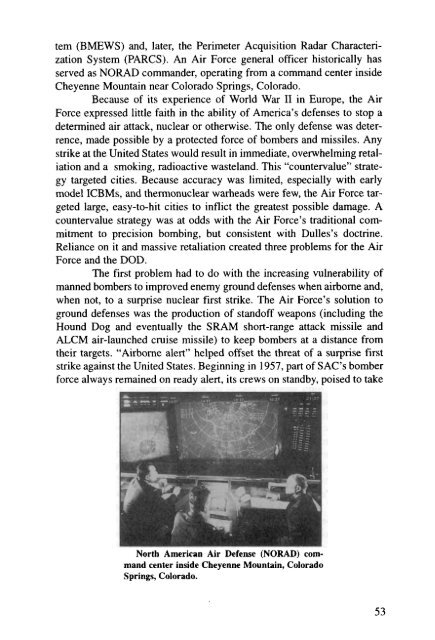A Concise History of the US Air Force - Air Force Historical Studies ...
A Concise History of the US Air Force - Air Force Historical Studies ...
A Concise History of the US Air Force - Air Force Historical Studies ...
You also want an ePaper? Increase the reach of your titles
YUMPU automatically turns print PDFs into web optimized ePapers that Google loves.
tem (BMEWS) and, later, <strong>the</strong> Perimeter Acquisition Radar Characteri-<br />
zation System (PARCS). An <strong>Air</strong> <strong>Force</strong> general <strong>of</strong>ficer historically has<br />
served as NORAD commander, operating from a command center inside<br />
Cheyenne Mountain near Colorado Springs, Colorado.<br />
Because <strong>of</strong> its experience <strong>of</strong> World War I1 in Europe, <strong>the</strong> <strong>Air</strong><br />
<strong>Force</strong> expressed little faith in <strong>the</strong> ability <strong>of</strong> America’s defenses to stop a<br />
determined air attack, nuclear or o<strong>the</strong>rwise. The only defense was deter-<br />
rence, made possible by a protected force <strong>of</strong> bombers and missiles. Any<br />
strike at <strong>the</strong> United States would result in immediate, overwhelming retal-<br />
iation and a smoking, radioactive wasteland. This “countervalue” strate-<br />
gy targeted cities. Because accuracy was limited, especially with early<br />
model ICBMs, and <strong>the</strong>rmonuclear warheads were few, <strong>the</strong> <strong>Air</strong> <strong>Force</strong> tar-<br />
geted large, easy-to-hit cities to inflict <strong>the</strong> greatest possible damage. A<br />
countervalue strategy was at odds with <strong>the</strong> <strong>Air</strong> <strong>Force</strong>’s traditional com-<br />
mitment to precision bombing, but consistent with Dulles’s doctrine.<br />
Reliance on it and massive retaliation created three problems for <strong>the</strong> <strong>Air</strong><br />
<strong>Force</strong> and <strong>the</strong> DOD.<br />
The first problem had to do with <strong>the</strong> increasing vulnerability <strong>of</strong><br />
manned bombers to improved enemy ground defenses when airborne and,<br />
when not, to a surprise nuclear first strike. The <strong>Air</strong> <strong>Force</strong>’s solution to<br />
ground defenses was <strong>the</strong> production <strong>of</strong> stand<strong>of</strong>f weapons (including <strong>the</strong><br />
Hound Dog and eventually <strong>the</strong> SRAM short-range attack missile and<br />
ALCM air-launched cruise missile) to keep bombers at a distance from<br />
<strong>the</strong>ir targets. “<strong>Air</strong>borne alert” helped <strong>of</strong>fset <strong>the</strong> threat <strong>of</strong> a surprise first<br />
strike against <strong>the</strong> United States. Beginning in 1957, part <strong>of</strong> SAC’S bomber<br />
force always remained on ready alert, its crews on standby, poised to take<br />
North American <strong>Air</strong> Defense (NORAD) com-<br />
mand center inside Cheyenne Mountain, Colorado<br />
Springs, Colorado.<br />
53
















